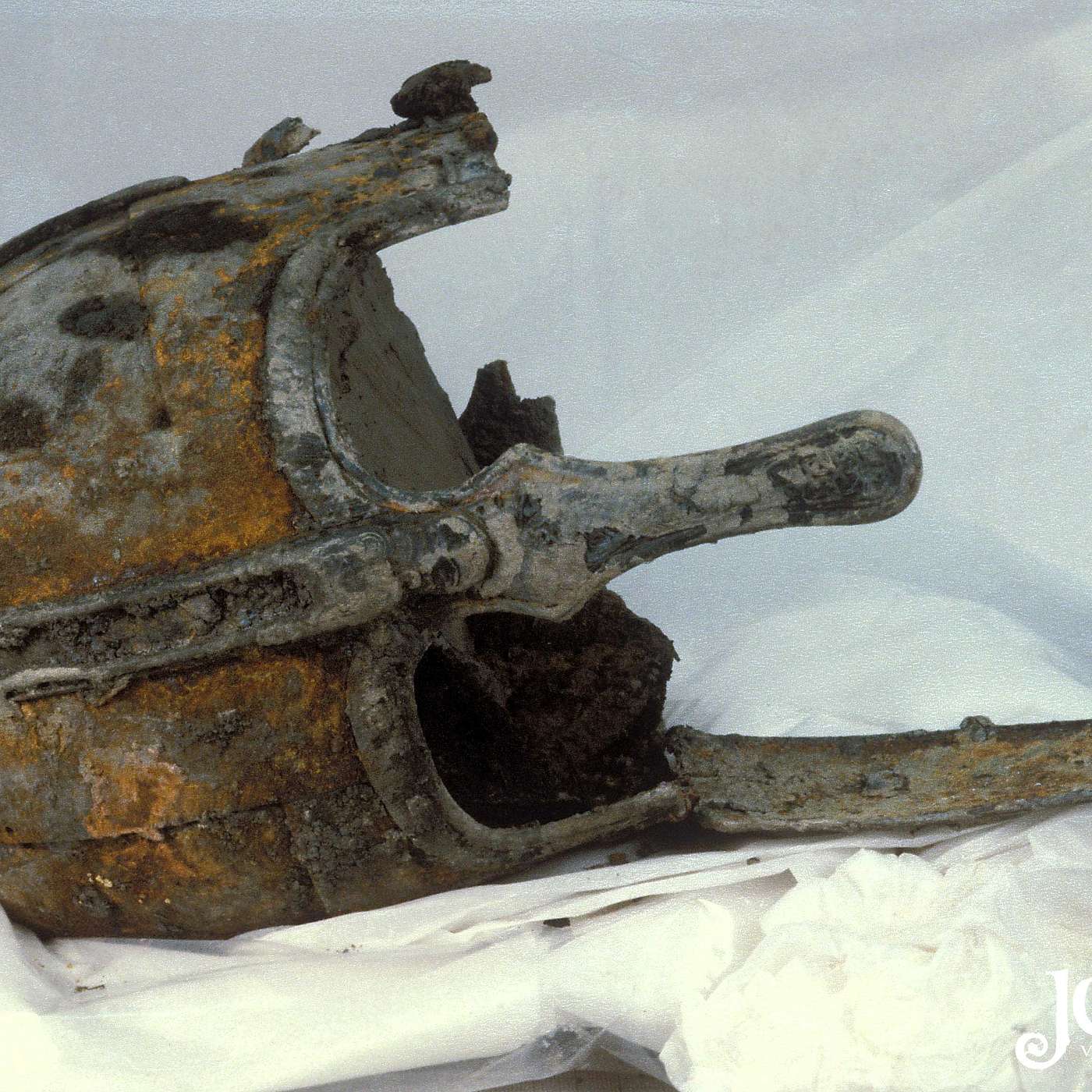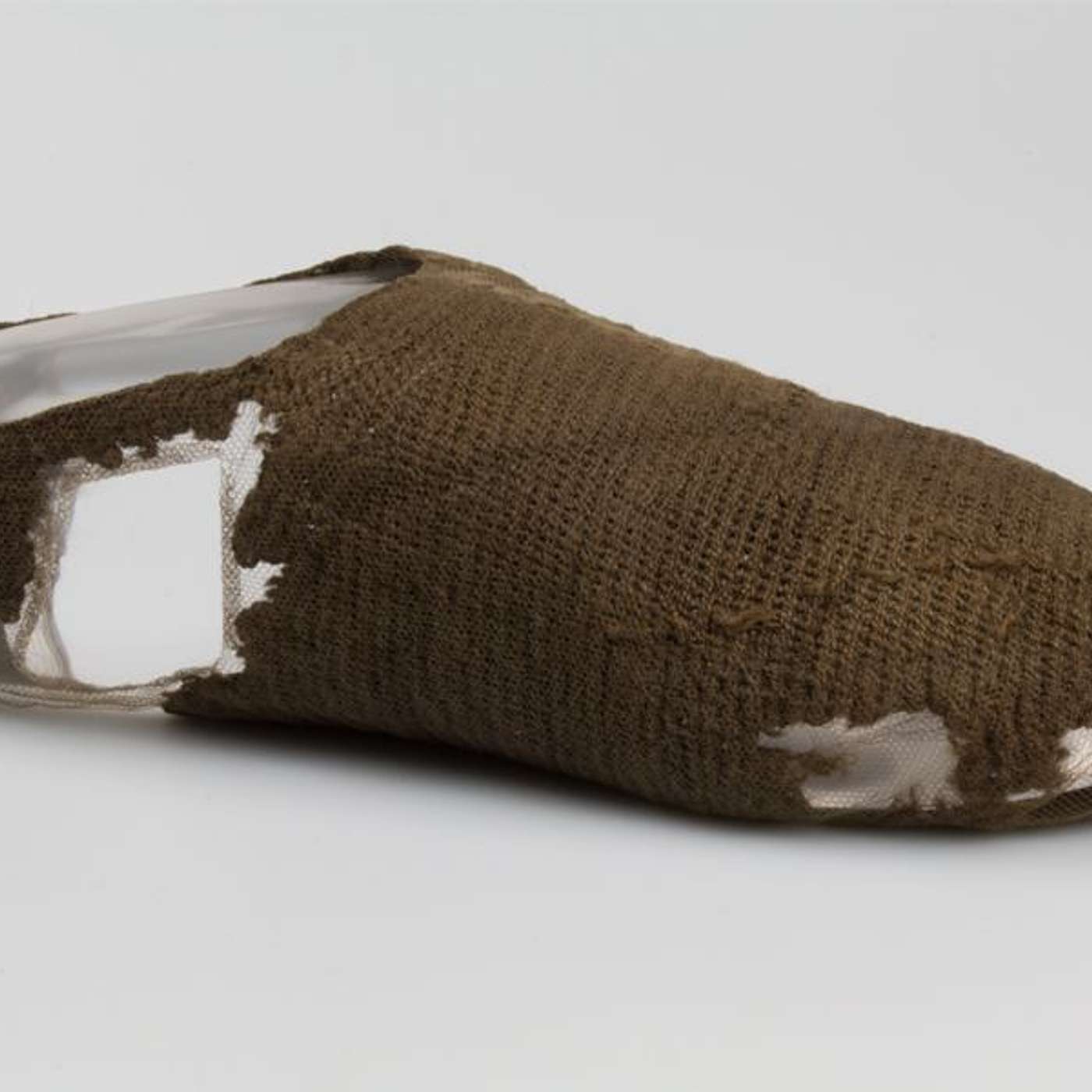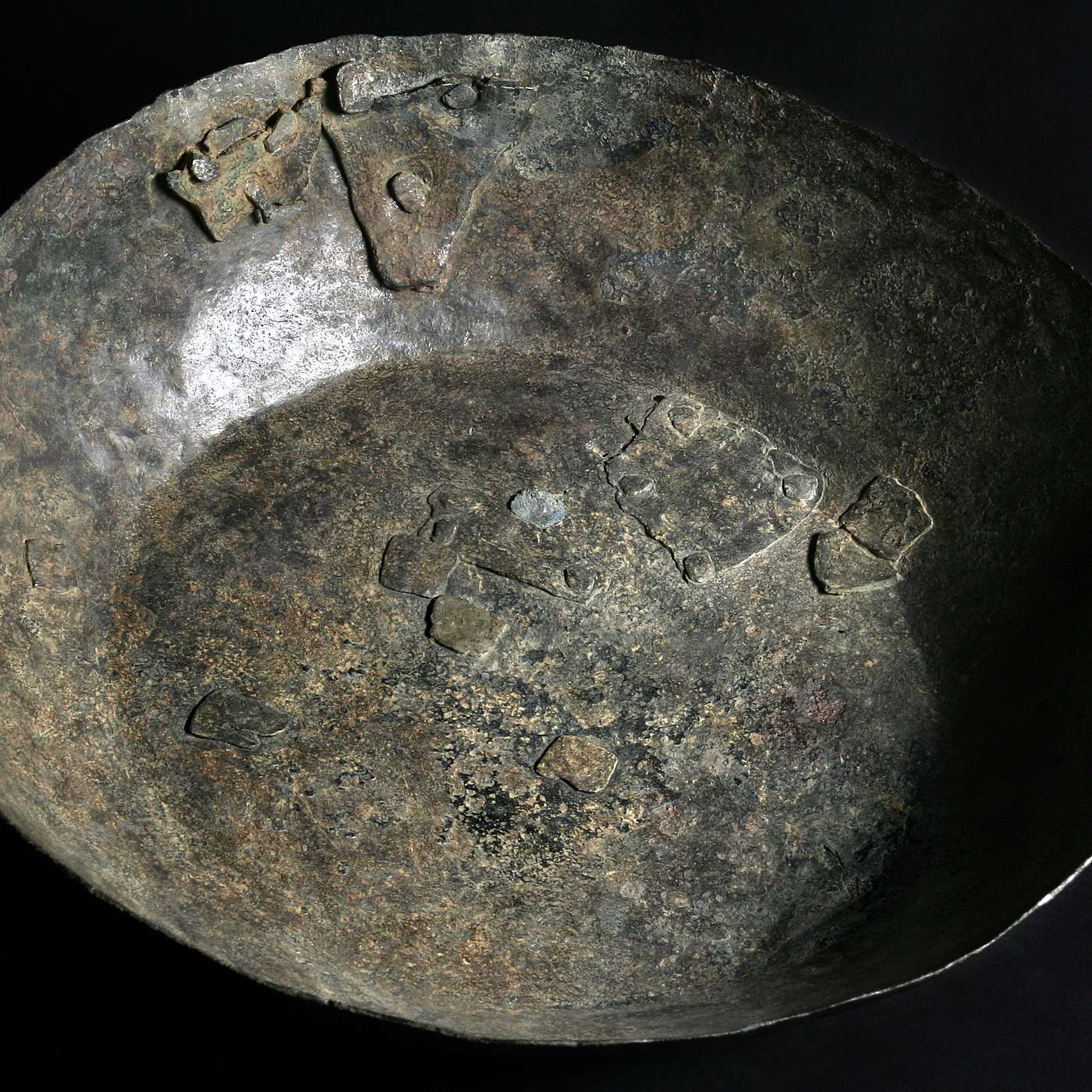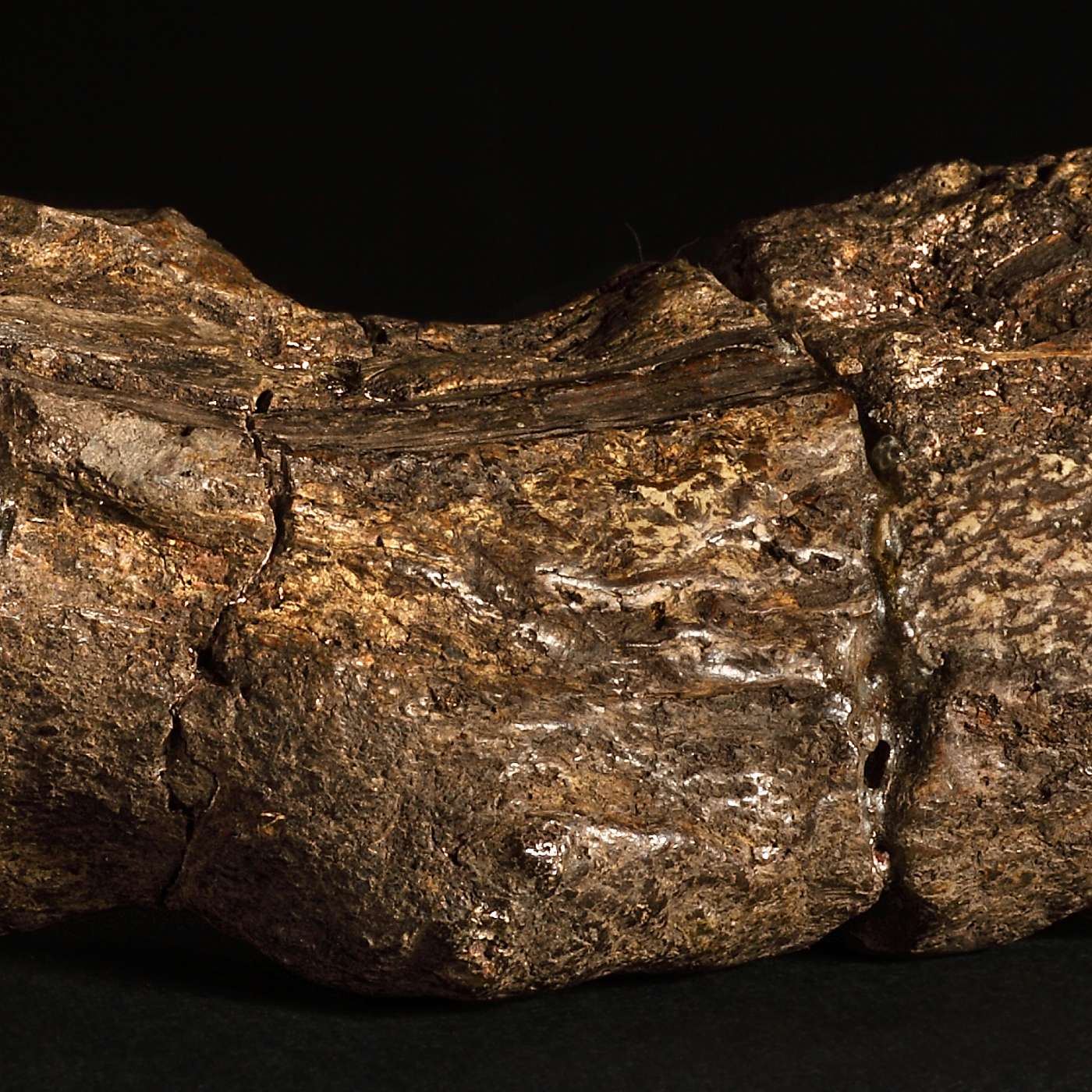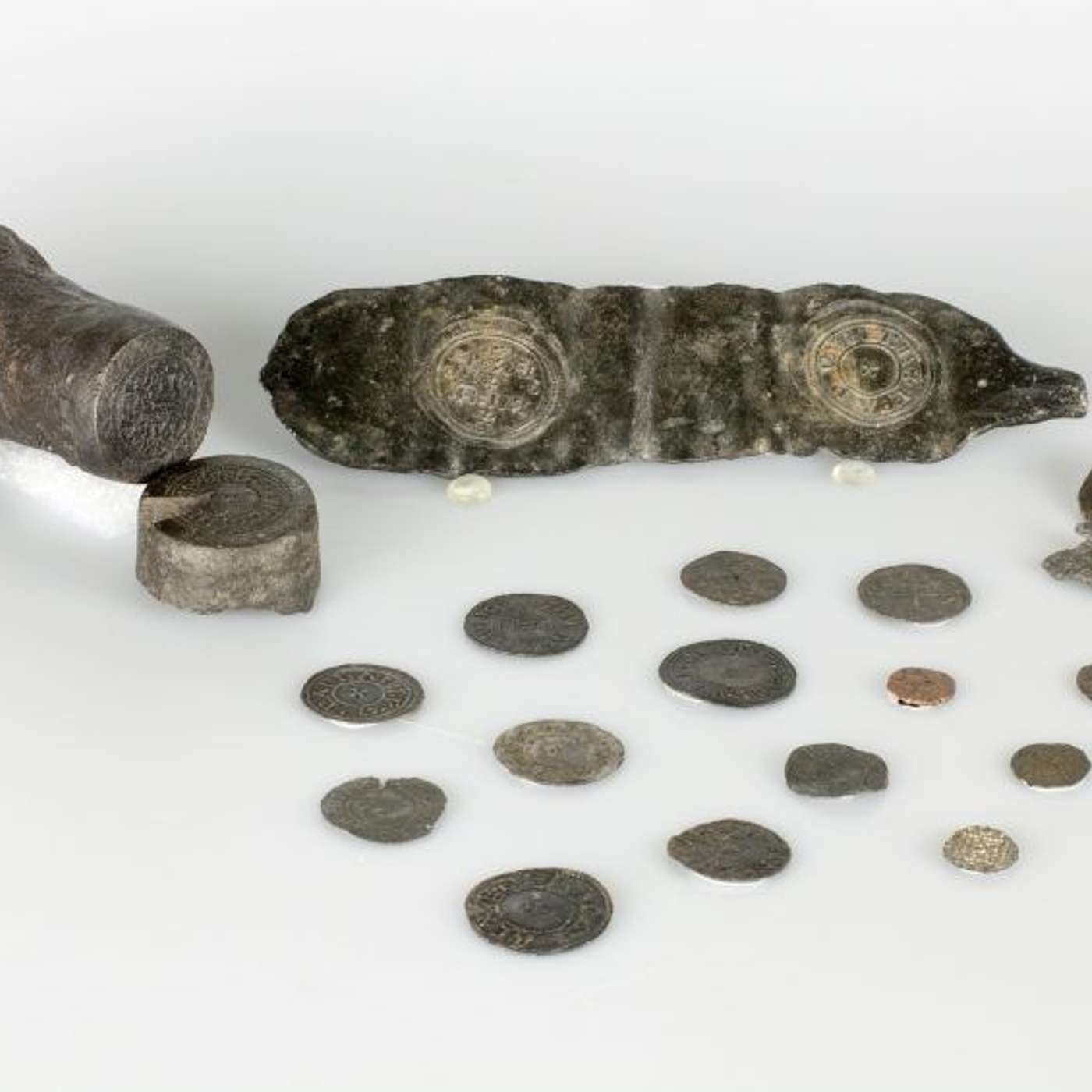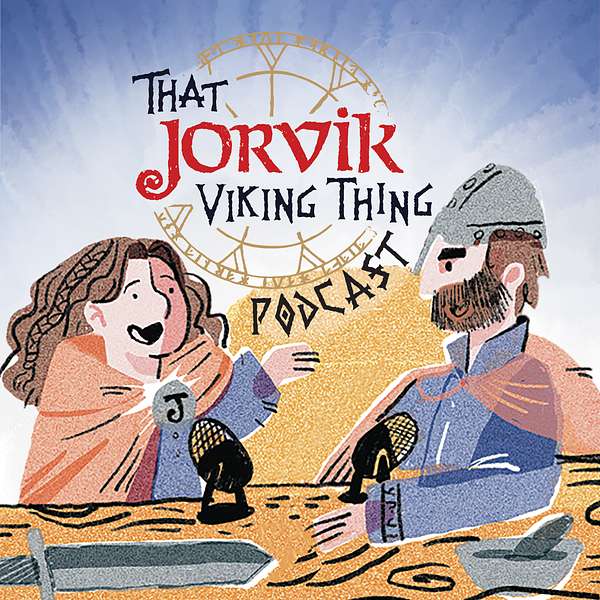
That JORVIK Viking Thing Podcast
In Viking times, a ‘Thing’ was a gathering; a place where leaders and warriors could meet and talk. In the 21st century, our ‘Thing’ is a virtual place where Viking academics and enthusiasts from around the world can come together to share knowledge.
Join Miranda and Lucas, from the JORVIK Viking Centre, as they delve into another fascinating topic about Vikings, archaeology, and more!
That JORVIK Viking Thing Podcast
The Coppergate Excavation: Viking Finds
We're continuing our deep dive on the Coppergate Excavation and talking to Rachel Cutler, Interpretations Assistant and Viking Interpreter here at the Jorvik Viking Centre. She tells us about four star Viking-age finds from the dig and gives a little more context of just how many things came out of the ground.
Listen and enjoy, and please consider leaving us a 5 star review on Apple Podcasts, Spotify or wherever you listen!
Miranda 0:01
In Viking times, a "Thing" was a gathering a place where leaders and warriors could meet and talk. In the 21st century, our thing is a virtual place, where history academics and enthusiasts from around the world can come together to share knowledge. I'm your host, Miranda Schmeiderer, and this season we're doing a deep dive into the Coppergate excavation. So hold on to your helmets for this episode of That Jorvik Viking Thing podcast.
Miranda 0:33
On last week's episode, we looked at the Coppergate excavation. If you haven't listened to it yet, make sure you go back and listen to episode one. Today we're going to talk about the Viking Age finds that were uncovered in the dig. Over the course of the five year excavation, millions of objects were recovered from the soil. Four and a half tonnes of animal bones, 750,000 oyster shells and 20,000 individual artefacts were recovered. Coppergate is best known for the Viking objects that were uncovered there and only a small portion of these artefacts can be displayed in our museum. But today we wanted to focus on some of the most spectacular Viking finds. We have with us today Rachel Cutler, Interpretation Assistant and one of our Viking interpreters from the Jorvik Viking Centre to share with us what she knows about four star Viking finds from the Coppergate dig. We'll start off with possibly the most famous item found in the dig: the Coppergate helmet. What can you tell us about the helmet Rachel?
Rachel 1:26
The Coppergate helmet is not actually a Viking helmet but an Anglian helmet excavated during the watching brief right at the end of the Coppergate dig in 1982, when planning was underway to develop a site into the shopping centre that it is today. By Anglian, we mean the period in post Roman Britain when the Germanic people known as the Angles settled in the North and East of England, as opposed to the Saxons who settled in parts of the south and southeast of England. What we call the Anglian period of the history of the north of England covers roughly from the 5th and 6th centuries, up until the mid 9th century, when large waves of Scandinavian people came to live in these parts also. But of course, when Scandinavian people settled in areas such as York, the Anglian people continue to live here also. Hence, Anglo Scandinavian is a better term to describe the late 9th and 10th centuries, rather than just Anglian or Anglo Saxon or Viking, because we have a lot of evidence from archaeology of the two cultures mixing.
Rachel 1:26
The Coppergate helmet was found in a wood-lined pit in a Viking-age back garden. Although the pit itself was created in the Anglo Scandinavian period, and it's been dated to sometime around the year 900, the helmet itself is pre Viking, and it's been dated to 750 to 775. So by the time it was buried in this pit, it was a century old, it was clearly used. It shows wear and has been damaged by a sharp projectile, unlike the Sutton Hoo helmet, which seems to be in a king's ceremonial helmet and shows no battle scarring. The survival of the Coppergate helmet is incredibly lucky. It narrowly missed destruction by a massive brick chimney in the 19th century, and then it was nearly destroyed by mechanical digger when it was found in 1982. The Coppergate helmet is one of only five Anglo Saxon helmets ever found, and it's the most complete and the best preserved of them all. It is a mystery how the helmet came to its final resting place, however, but one possibility is that it might have been worn during the struggle for York between the Vikings and the Northumbrians in 866.
Rachel 3:19
But helmet was constructed out of iron with cheek pieces like a Roman helmet and a chain maille neck guard. When it was found, one cheek piece was still attached, whereas the other cheek piece and the maille neck guard had been placed within the helmet. This chain maille neck guard was constructed out around 2,000 rings, so this is also a really rare and exciting survival of chain maille from this period. Unlike the Sutton Hoo helmet, this helmet does not cover the majority of the wearer's face, but it does have a nasal guard, which is a brass strip running downwards from between the eyes to cover the nose. The helmet has copper alloy fittings such as eyebrows with animal heads at each end, and a separately cast animal head above the nasal guard. The copper alloy decoration on the helmet is incredibly intricate and it's really beautifully made. There's a variety of different animal heads and really lovely interlaced designs.
Rachel 4:06
In addition to all this decoration that you would see if you were facing somebody wearing the helmet, on top there are also brass strips across the top of the skull forming the shape of a cross. On these brass strips we can read an inscription in Latin. In English, this inscription says "in the name of our Lord Jesus, the Holy Spirit, God the Father, and with all we pray, amen, Oshere XPI." So XPI is the first three letters of Christ in Greek. Oshere is an old English personal name - Oshere it is thought to maybe be the owner of the helmet, although he might have been the craftsman or maybe even the man who commissioned it as a gift. This helmet is clearly high status, made for an important person, so perhaps it might have been worn by a royal ruler of the Kingdom of Northumbria, but Oshere's identity remains a mystery. The inscription on the helmet is clearly a Christian one. Northumbria had been Christian for at least 100 years by the time this helmet was made. The prayer could be an attempt to reinforce the helmet's physical protection with spiritual protection from God. Aside from the inscription on the Coppergate helmet, the design is similar to that of the Wollaston helmet, which is another Anglo Saxon helmet excavated in Northamptonshire, except the Coppergate helmet is much more richly decorated. And the Wollaston helmet has a little ball at the top of the skull, so quite different.
Rachel 5:22
The helmet was in really good condition when it was excavated, despite being filled with clay soil, but the lack of oxygen in the water-logged soil had prevented the metal of the helmet from corroding. The archaeologists were concerned that drying out the helmet will cause all of the clay inside the helmet to be too hard to remove. So instead of excavating it straight away, the section of earth containing the helmet was lifted carefully from the pit, and the helmet was stored wet with all this earth until it could be properly investigated. The helmet was X-rayed to see if there's anything in the helmet along with all the modern clay. And indeed, this X-ray revealed the missing cheek piece and the chain maille neck guard. So the next job was to remove the damp clay and the soil from inside the helmet, which was done really slowly and carefully. The helmet was then restored at the British Museum and iron plate from the top of the helmet, which had been damaged, was carefully refitted and the chain maille neck guard was reattached, and the second cheek piece was also reattached.
Miranda 6:17
If you look at the helmet today, you'll notice that it looks quite different than most of our other objects. Because the helmet was such a significant find, the York City Council decided to restore the helmet rather than simply conserve it. When restoring an artefact specialists will work to restore the piece to its original appearance and function, including adding new bits if necessary. On the Coppergate helmet you can see these new bits clearly as they don't have the same decoration as the original parts of the helmet. Conservation, on the other hand, focuses on maintaining the piece as-is, so that future generations will be able to enjoy the item for years to come. We'll talk more about conservation work in Episode Four of this season.
Miranda 6:56
As we've mentioned before, Vikings have been associated with fighting for a very long time, and you might think that finding the Coppergate helmet would only reinforce that image. Aside from the helmet we found a spearhead, some fragments of a sword and a seax, a type of knife with a single-edged blade. All of these items sound like they'd be perfect on the battlefield. But actually most of them are far more domestic in use than you might think. The seax in particular may sound rather threatening, especially since we found hundreds of seax sheets on Coppergate. But really, it's just a big knife that a lot of Saxons during that time period carried around with them. They would use the seax to cut their food, cut leather, even butcher an animal if necessary. People could use a seax to defend themselves, but rarely did these items see the battlefield, At least from the residents of Jorvik.
Miranda 7:44
But the Anglo Scandinavians of Jorvik had more than just these potential weapons. Coppergate gave us a look into clothing they wore as well. The prized artefact in this collection is a mostly complete woollen sock, affectionately known as the Coppergate sock. Can you tell us more, Rachel?
Rachel 8:01
So the Coppergate sock is the only Viking sock ever found. It was excavated in a pit in the mid 10th century levels of Coppergate. The sock isn't a long sock or stocking, it stops at the ankle, so it was quite small to look at, but it would fit somebody with a UK size 8 foot. The sock is made with a single needle technique called nalebinding, which is a Danish term meaning "needle binding." It's quite different to knitting and crochet. A single needle is used to make interlocking loops of yarn. And it's a very slow technique, but it can be used to create really warm, hardwearing small items such as socks, as well as hats and mittens. The woollen yarn that this sock is made from is incredibly fine and the stitches are really tiny, so it would have taken many hours of work to produce this one sock. But there's a long history of nalebinding in continental Europe and the Middle Ages. In the Viking period, there are two examples of nonbinding mittens from Iceland, and a cap from 9th or 10th century Egypt. But there are no other nalebinded socks, and there's very little evidence of this craft in Britain. Therefore, it has been suggested that this sock arrived in York on the foot of a Scandinavian settler. However, in the excavation we also found some bone needles that could easily have functioned as nalebinding needles, so it could have been made here in York. There are lots of different types of stitches in nalebinding, some creating much thicker and tougher fabrics than others. The type of stitch that was used to make this sock is unique, and it's been named the York stitch. From my own experience of nalebinding, the York stitch is perfect for making socks because it is really dense and hardwearing but still has a little bit of stretch to help pull the socks on and off.
Rachel 9:34
This sock is made of undyed wool with a red band at the top. Nalebinding does not unravel like knitting or crochet, so no special finishing border is needed. So this last red row could have been a decorative edge. But the sock might not always have been an ankle sock. It could have actually continued upwards as a stocking but was later trimmed. This band of red at the top could be all that was left of the rest of the sock being made from red wool or perhaps other colours were originally present too. If you view this in the Jorvik galleries, you can tell that this was a very well used item. It has been darned in places and there are some holes that were left unrepaired before it ended up in the ground. And of course, we don't know where the second sock is. On the ball of the foot of this sock, you can see an outline of stitches, showing where there probably was a large rectangular patch sewn to cover a hole, but that patch is now missing. A question we often get asked at Jorvik is did every Viking wear socks? It's impossible to say whether the socks were a common garment in the Viking Age, because socks and other textile remains do not usually survive in archaeology. And socks are also hard to distinguish in images from this period. At Coppergate, the waterlogged soil has meant that the sock and other textile remains were really well preserved.
Miranda 10:41
The Coppergate sock has actually been named one of the most important artefacts in the north as part of "A History of the North in 100 Objects." It's an initiative that encourages visitors to explore history's greatest treasures as part of the Great Exhibition of the North. The red dye used on the top part of the Coppergate sock was actually a fairly common colour in Jorvik, made from a plant called madder. More traces of this dye were found than any other dye material. Other colours that residents of Jorvik were wearing included blue, yellow and green, making it a very colourful place indeed.
Miranda 11:16
Aside from the sock, bits of linen, woollen and even silk textiles were found during the excavation. Though most were only small fragments, a golden brown silk headdress was found. It's unlikely that silk was made on Coppergate, so this cap probably came to York by traders from the East - further evidence that York was a busy centre of trade amongst the Vikings. In addition to the finished products, archaeologists found many artefacts used in the production of textiles. Raw wool itself managed to survive 1,000 years in the wet soil, as well as flax used to make linen. Spindles and spindle whorls, both used in spinning, were found in droves. During the excavation, even pieces of looms were found, meaning that every part of the textile production happened on Coppergate, from washing the wool all the way up to the weaving of the cloth. And of course, mending too. We know that thanks to the 243 needles that were found on the site.
Miranda 12:10
It's very clear that the Vikings had a "make do and mend" sort of attitude towards their possessions. And this extended not just to their clothes, but to their cooking utensils as well. Rachel, can you tell us a little bit about the Coppergate frying pan?
Rachel 12:24
This frying pan is one of the many domestic artefacts and cooking utensils excavated from Anglo Scandinavian Coppergate and it resembles a modern wok. The pan is made from a single sheet of iron that was beaten into shape, you can see the marks from the hammer on the inner surface, particularly around the rim. It originally would have had a handle nailed to the inside of the pan, which is unfortunately now missing but you can see two terminal plates to attach the handle. In comparison to other metal cooking vessels from Viking age Scandinavia, this frying pan is unusual because it is shaped and used like a frying pan, whereas Scandinavian examples tend to be more like cauldrons with drop handles. In the Coppergate dig, we found five other fragments which might have been from similar vessels, but it's really difficult to tell whether they would have actually been a frying pan in shape. A similar frying pan to this one was however excavated in Winchester, and this one had a long handle with a loop at the end to hang it up. So perhaps cooking with a frying pan was more of a Saxon technique that later spread to Jorvik. The most interesting thing about this frying pan is that it was patched and repaired multiple times throughout his life. There are two patching plates which were riveted in place to cover large holes. One of these is made from iron and the other is made from lead, which may not have been the best choice for something to prepare food from. There are another seven additional rivets to cover smaller holes, and large metal items like this pan probably would have been a big investment, so repairs like this were essential for getting as much use out of it as possible.
Miranda 13:50
As well as the frying pan, plenty of other kitchen items were uncovered at Coppergate. Quern stones, used to grind cereal grains, were made out of limestone, sandstone, and more often than not, lava stone. Bowls were made out of stone, wood or metal, and cups were commonly made out of wood. Even spoons were found at Coppergate, mostly made out of metal. And of course hundreds of thousands of pieces of pottery were found. Recently, archaeologists have begun research on pottery fragments like these to determine what the Vikings were eating.
Miranda 14:21
Our final object is a little bit different. It was made by a Viking but in a very special sort of way. Here's Rachel one last time. Rachel, what can you tell us about the Lloyds Bank Coprolite?
Rachel 14:34
This object was not actually excavated in the Coppergate dig but it's still probably the most famous and most popular artefacts on display at Jorvik. The word "coprolite" comes from the Greek meaning "poo stone" and it's used to refer to fossilised poo. It is nearly 20 centimetres long and 5 centimetres wide, making it the largest human coprolite ever found. It was unearthed in the excavation underneath Lloyds Bank on Pavement in York City Centre, which is just around the corner from Coppergate. As well as unearthing this famous faeces, this excavation was important because it revealed that the Anglo Scandinavian levels at York were incredibly well preserved, and therefore showed that the Coppergate site, which was Cravens sweet factory at the time, had real potential for Anglo Scandinavian archaeology, just like we talked about in Episode One.
Rachel 15:19
Human coprolites can provide information about what people were eating, and also provide information about the state of health as well. The Lloyds Bank Coprolite is by no means the only Anglo Scandinavian poo ever found in York, but since it is not only huge, but also all in one piece, it is clearly from one individual, so it gives us a fascinating glimpse into this one individual's health and diet, whereas most of the other coprolites from Lloyds Bank and other Anglo Scandinavian sites in York is from mass cesspits, which would have been used by multiple individuals so all the small pieces of copyright are mixed up. Human waste does not always survive in archaeology. Quite specific conditions are needed to preserve faeces and turn it into coprolite. Wet, waterlogged soil is very helpful for this as the calcium salts in the water from the wet soil gradually replace some of the organic material in the poo and it becomes mineralized. At Lloyds Bank Pavement, the ground consisted mostly of richly organic layers with a large amount of incompletely decayed plant matter, which helps explain why the coprolite was so well preserved.
Rachel 16:21
The Lloyds Bank coprolite was excavated at the deepest point of the excavations at Lloyds Bank, and it was originally thought to be a piece of metalworking waste until biological investigations have shown that it was in fact mineralized human poo. Analysis on this coprolites revealed that it contains a lot of cereal bran. Bran is the hard outer layers of cereal crops and the human body cannot digest the bran from cereal, so it remains in the poo. The person who deposited the Lloyds Bank Coprolite must have had a really high fibre diet. Other coprolite samples from Anglo Scandinavian York also contain things like seeds from fruits and vegetables, but the Lloyds Bank Coprolite did not, suggesting that this person had a less healthy and less varied diet.
Rachel 17:01
Looking at coprolites is a useful way to understand health and hygiene in the Anglo Scandinavian period. This coprolite contains the eggs of whipworms and maw worms, telling us that this individual was infested with numerous parasitic worms. These parasites are spread when faeces contaminate food crops, or when food is prepared with dirty hands. Having a small number of gut worms isn't usually a problem for healthy individuals, but this person had a particularly large infestation, and this would have caused some serious stomach aches, diarrhoea and inflammation of the bowel. It's difficult to tell whether the quantity of parasites in this coprolite was typical for this period, or whether this person had an unusually bad infestation. We do know that the person who produced this poo had at least a small number of whipworms and several hundred maw worms. Today that would be classed as a heavy infestation, but it would not necessarily affect the individual's ability to go about with daily life. In other Anglo Scandinavian sites in York, parasite eggs have also been recovered from coprolites samples in latrine pits or cesspits. And some have also been found on samples of the moss which would have been used as toilet paper. So we cannot determine whether these other parasite eggs are from multiple individuals, or just a small number of individuals as multiple people would have shared these latrine pits, so their poo got all mixed up.
Miranda 18:19
Thanks so much for sharing your knowledge with us today, Rachel.
Miranda 18:22
Finally, we have an update from our last episode. Peter Addyman, the founding director of York Archaeological Trust, commented on his favourite find from the Coppergate excavation.
Peter Addyman 18:33
What were the most memorable finds? It's difficult to select when there were more than 39,000 of them. But a squashed beehive complete with well preserved bees stands out in my mind.
Miranda 18:47
In researching this episode, we've discovered that this beehive was not in fact a beehive. The object recovered was actually a length of twisted rope wound into a pile surrounded by thousands of fragments of the wings. It was a reasonable assumption when it was first uncovered that this might have been a domed beehive called a bee skep. However, no further testing has ever been done on the object as it's gone missing in the nearly 50 years since it was first discovered, but it's unlikely that it was a bee skep. The bees on the other hand, were still around until the 1980s, when a pair of bee enthusiasts looked closely at the wings. They determined that these bees were the British dark bee, a wild native honeybee. These bees in fact were found in numerous places all around Coppergate along with blocks of beeswax. We now think that bees were a common insect and that they probably were kept on or near Coppergate. The Vikings very likely kept bees for honey and beeswax, but we don't actually have any evidence of the beehives themselves.
Miranda 19:48
Peter also mentioned all the various artefacts related to coin production found at Coppergate, including a slightly confusing coin that isn't quite what it seems. This particular coin is called a dirham, and it was made in the Arabic Kingdom of Samarkand, where Uzbekistan is today. Plenty of dirham like this circulated throughout the Viking world. But what makes this one special is that it's not a real dirham. It's a forgery. Not a modern day forgery, but a 10th century one. It was made from a piece of copper covered in tin to make it look like a genuine silver coin, and it was also stamped with the name of the Caliph of Samarkand, Isma'il Ibn Ahmed. We think this was minted somewhere near Samarkand, then travelled 3,000 miles across Europe and Scandinavia before it found its final resting place here in Jorvik. Whether or not the Vikings here could tell this was a fake is open for debate, but there was plenty of coins flowing in and out of the city.
Miranda 20:44
More than just coins, we found the actual dies that the coins were struck from. A coin die is one of two pieces of metal used to strike a coin. The coin blank, a piece of blank silver in this case, is placed between the dies, which are then struck with the hammer. Take the dies away, and the pattern from the dies has been imprinted onto the coin. These dies were beyond the skill of a regular blacksmith, so it was probably a jeweller or other specialised metal worker who were in charge of creating these dies. One of the dies had a part of it chiselled out, which makes us think it had reached the end of its usefulness and was on its way to being melted down and forged again. How it ended up in the mud and not in the fire is a mystery, but one we're grateful for since it gives us a tiny peek into how objects like these were used, not just how they were made.
Miranda 21:31
In addition to the coin dies, we also found a trial strip of lead that was used to double check these dies. The metal worker could stamp this lead strip as a means of quality control. Good thing too, as one of the impressions of the strip turned out backwards. That means the die was completely useless and the poor metal worker had to start all over making the die from scratch again, it seems like the process of making these coin dies was more intensive than making the coins themselves.
Miranda 21:58
We hope you enjoyed our look at the Viking star finds from Coppergate. Special thanks to Rachel Cutler for being our guest today. Also thanks to Lucas Norton and Max O'Keeffe for their help with the Coppergate beehive research. In our next episode, we'll welcome back Dr. Chris Tuckley, head of interpretation and engagement from here at York Archaeological Trust. We'll talk to him about other finds that are normally forgotten when we talk about the Coppergate excavation: finds from the Roman, Medieval, and even Victorian periods. These artefacts might not be as famous but they help us to understand the bigger picture of life on Coppergate before, during, and after the Viking Age. If you missed Chris's previous episode, make sure to give it a listen to learn all about how Viking history has been celebrated in Yorkshire for over 100 years - Season One, Episode Three. Stay tuned for the rest of the season as we examine the non Viking finds that often get overlooked, learn how these artefacts were preserved in the ground and now in our museum, and finally discuss how Coppergate changed our understanding of Vikings in the British Isles. Even more exciting, the Jorvik Viking centre reopens the 17th of May 2021. Book your tickets now at JorvikVikingCentre.co.uk. Come and see where it all happened and look at these amazing finds for yourself.
Miranda 23:19
Did you know that That Jorvik Viking Thing podcast is an Audible Associate? Click the link in our shownotes or go to audibletrial.com/vikingthing-21 to sign up for a free 30-day Audible trial. When you do, you'll get a free audiobook download, and you'll also be supporting your favourite Viking podcast. Even better, the audio book is yours to keep forever, no strings attached. This time we recommend....
“Women's Work: The First 20,000 Years: Women, Cloth, and Society in Early Times” by Elizabeth Wayland Barber. Twenty thousand years ago, women were making and wearing the first clothing created from spun fibers. Right up to the Industrial Revolution, the fiber arts were an enormous economic force, belonging primarily to women. Despite the tremendous effort required in making clothing, most sources on ancient history and economics have no information on them, due in part to the extreme perishability of what women produced. Author Elizabeth Wayland Barber has drawn from data gathered by the most sophisticated newer archaeological methods - methods she herself helped to fashion. If you enjoyed hearing about the textiles found at Coppergate you’ll love Women’s Work.
Thank you for listening to That Jorvik Viking Thing podcast. You can find us on Spotify, Apple podcasts, and anywhere you get your podcasts. If you'd like to support That Jorvik Viking Thing, visit JorvikThing.com to make a donation. Don't forget to hit subscribe so you don't miss the next episode of That Jorvik Viking Thing podcast. Want to have a say in the future of your favourite Viking podcast? Click the link in the show notes to take a quick survey and let us know what you’d like to hear in future seasons! Transcripts and chapter markers are available on JorvikThing.Buzzsprout.Com.
Miranda 25:02
That Jorvik Viking Thing Podcast is a production of the Jorvik Group and York Archaeological Trust. Researched by Miranda Schmeiderer and Ashley Fisher. Written and produced by Ashley Fisher. Sound designed and edited by Miranda Schmeiderer.
